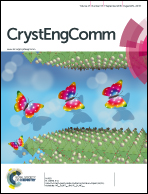Exploring the influence of steric hindrance and electronic nature of substituents in the supramolecular arrangements of 5-(substituted phenyl)-2-formylpyrroles†
Abstract
A family of 5-(substituted phenyl)-2-formylpyrrole compounds, exhibiting different electronic and steric features at the phenyl ring, was synthesised through the formylation reaction of the corresponding 2-(substituted phenyl)pyrrole precursors, using Vilsmeier–Haack acylation conditions. The products were obtained in moderate to high yields, being systematically characterised by NMR spectroscopy, elemental analysis and single crystal X-ray diffraction. The corresponding crystalline packings were discussed on the basis of three types of arrangements, leading to the formation of dimers, polymers or the newly observed tetramers, all of them essentially governed by strong N–H⋯O hydrogen bonding interactions. Important C–H⋯O, C–H⋯π, π⋯π and, in the case of fluorinated compounds, C–H⋯F interactions also contributed to the growth of the three-dimensional crystalline network. DFT calculations helped to rationalise the relationship between the steric and electronic properties of the molecules and the basic units observed in the corresponding solid state structures.


 Please wait while we load your content...
Please wait while we load your content...